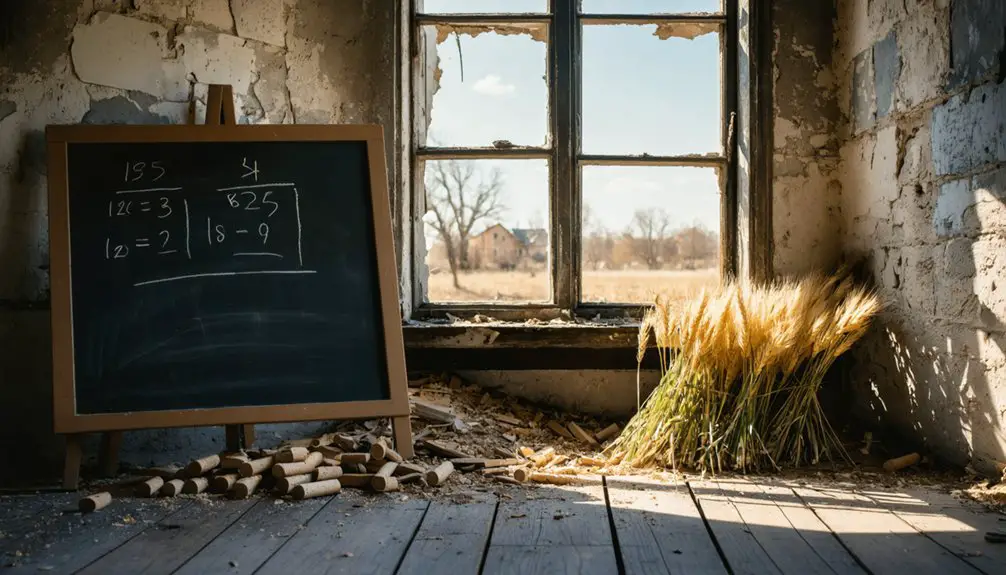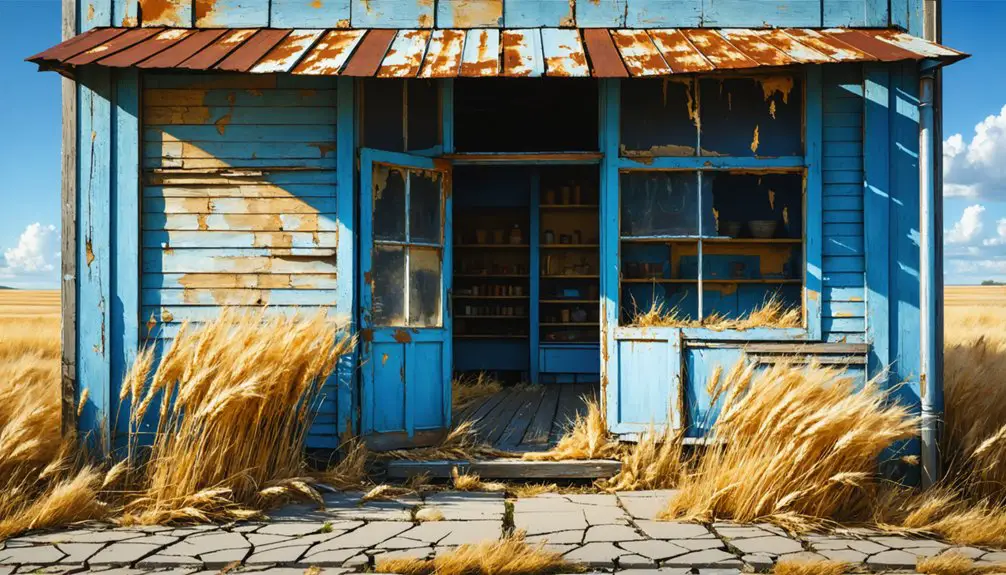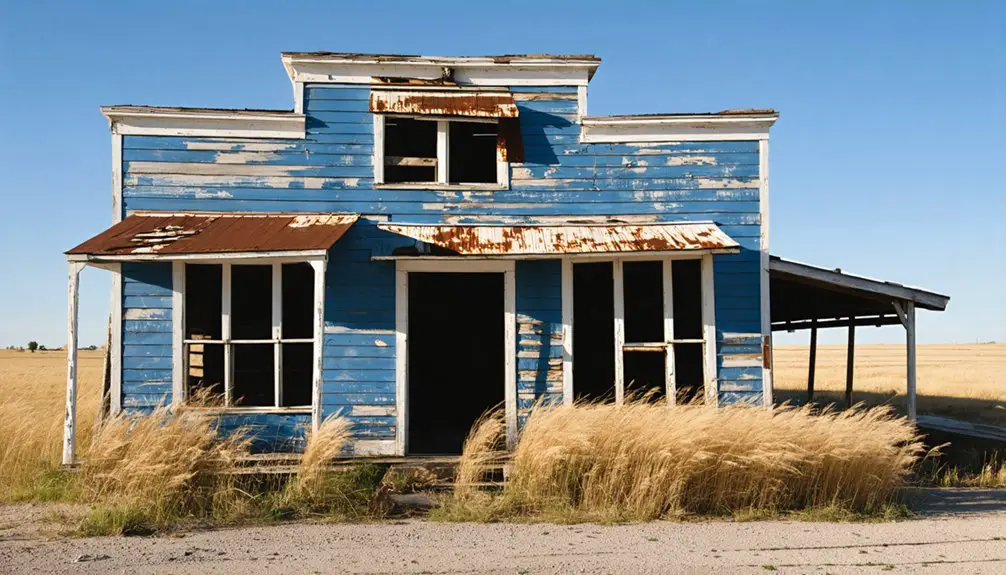You’ll find Granada’s ghost town story in Nemaha County, Kansas, where it began as Pleasant Spring in the 1850s. The settlement thrived as an essential Pony Express stop and stagecoach station, later transforming into a bustling railroad hub along the Santa Fe Trail. When the railroad terminus moved to La Junta in 1875, Granada’s decline began. Today, only scattered ruins and foundations remain, each telling tales of frontier ambition and adaptation.
Key Takeaways
- Originally established as Pleasant Spring in the 1850s, Granada became a significant stagecoach stop and Pony Express station in Kansas.
- The town flourished in the 1870s with multiple businesses, including T.B. Nolan’s general store, hotels, saloons, and essential services.
- Granada’s decline began when the Atchison, Topeka, and Santa Fe Railroad moved its terminus to La Junta in 1875.
- Economic factors like agricultural mechanization, youth migration, and railroad route changes led to Granada’s eventual ghost town status.
- Historic remnants include a brick high school, grain elevators, and deteriorating business buildings that showcase the town’s former prosperity.
The Birth of Pleasant Spring
During the tumultuous 1850s, Pleasant Spring emerged as a distinctive settlement in Nemaha County, Kansas, where pro-slavery settlers led by Cyrus Dolman established their foothold amid widespread free-state sentiment.
The founding challenges were significant, as you’d expect in a region where ideological tensions ran high and community dynamics were shaped by the broader conflicts of Bleeding Kansas.
Despite being surrounded by free-state supporters, the settlement quickly developed essential infrastructure.
You’ll find that the early settlers wasted no time in establishing a post office in 1856, along with stores, a sawmill, and blacksmith shops.
They took advantage of the area’s natural resources, including springs and timber, while building schools and churches to serve the growing population’s needs.
Like many mining towns of the era, the area experienced dramatic population swings, with places like Pitcher, Oklahoma reaching nearly 15,000 residents during peak mining operations.
Similar to the residents of Brooklyn in Lynn County, many settlers evacuated their homes due to fears of violence, temporarily seeking refuge in neighboring territories.
From Pleasant Spring to Granada
As transportation networks expanded across Kansas in the mid-1800s, Pleasant Spring’s strategic location along the Central Overland California and Pike’s Peak Express routes shaped its evolution into Granada.
Pleasant Spring’s origins as a stagecoach stop made it a crucial link for westward travelers and mail services between 1859 and 1863. The area’s abundant clear water springs provided essential resources for travelers and settlers alike.
Stagecoach travelers found essential refuge at Pleasant Spring, a vital waypoint serving pioneers and mail carriers during America’s westward expansion.
You’ll find Granada’s significance marked by the official post office name change on September 19, 1864, reflecting the settlement’s growth beyond its humble beginnings.
This transformation represented more than just a new name – it symbolized the community’s development from a simple rest stop into an established frontier settlement.
The change aligned with broader regional developments, though like many frontier towns, Granada’s prominence would eventually fade as transportation patterns shifted away from stagecoach routes. The area’s geography of 95% prairie land influenced the settlement patterns and economic activities of early residents.
Life Along the Pony Express
The Pony Express brought unprecedented energy and innovation to Granada’s frontier landscape in 1860, transforming this Kansas waystation into an essential link in America’s fastest mail delivery system.
You’d find hardy young Pony Express riders charging through Granada every few days, swapping their exhausted horses for fresh mounts as they raced to deliver mail across the continent in just 10 days.
Station life at Granada revolved around supporting these daring horsemen. The station master and staff maintained about a dozen horses, stocked provisions, and kept firearms ready. Letters were carefully wrapped in oiled silk to protect them from moisture damage during the treacherous journey.
When riders arrived with their leather mochila mail pouches, they’d quickly transfer them to fresh horses and continue their journey west toward Seneca and Marysville, or east toward St. Joseph, Missouri, battling weather and wilderness to keep America connected. The service proved remarkably efficient, completing the first westbound trip in just 9 days and 23 hours.
Commerce and Daily Activities
Life in Granada bustled with commercial activity throughout the 1870s, anchored by T.B. Nolan’s general store.
T.B. Nolan’s general store stood as the beating heart of Granada’s vibrant commercial scene during the bustling 1870s.
You’d find multiple grocery stores, a drug store, and Wright & Rath’s Hide Buyers supporting the town’s trade activities. Banking services emerged, though they proved unstable in the early years. Similar to Bell Plane’s early days, the land was purchased for 1.25 per acre.
As a railroad terminus town, Granada’s social establishments thrived. You could visit several restaurants, two hotels, or spend evenings at the saloons and dance halls. The town attracted famous Old West figures including Clay Allison and Doc Holiday.
Professional services included a doctor’s office, attorney, and post office. For your daily needs, you’d find barber shops and personal care services.
The town’s commerce was enhanced by basic infrastructure like coal oil street lamps and an irrigation canal, though it lacked formal government structures like law enforcement or city council.
Transportation’s Critical Role
When the Atchison, Topeka, and Santa Fe Railroad reached Granada in the early 1870s, you’d witness a transformation that would define the town’s destiny. The railroad significance became evident as it turned Granada into a significant transportation hub, following the old Santa Fe Trail along the Arkansas River’s north bank. The railroad’s construction brought home seeking settlers into the region, forever changing its demographic landscape.
- Experience frontier-era rail operations with wooden coaches and small steam engines
- Travel the Granada-Fort Union Military Road, a key route for military and civilian traffic
- Witness the transportation evolution from wagon trails to steam-powered mobility
You’ll find Granada’s fate intertwined with its role as a railroad terminus. When the terminus moved to La Junta in 1875, the town’s decline began. The nearby Metcalf tollgate operations played a crucial role in regional commerce until 1885.
Though Granada maintained essential services for another decade, its dependence on railroad commerce ultimately led to its ghost town status.
The Heartbeat of Rural Kansas
Deep within Kansas’s agricultural heartland, Granada stood as a vibrant community hub where farmers and ranchers gathered to trade goods, share stories, and build lasting connections.
You’d find the town’s rhythm in its community gatherings, from church socials to school events, weaving together the fabric of rural life. Agricultural practices shaped daily routines as farmers traded livestock, repaired equipment at the local blacksmith, and stocked up on supplies at the general store.
The post office served as a crucial communication link, while schools educated the next generation of prairie dwellers.
Rural institutions like post offices and schoolhouses formed the vital backbone of prairie communities, connecting people across Kansas’s vast landscape.
Granada’s social bonds proved resilient even as economic changes tested the town’s strength. While businesses might close, the spirit of community endured through informal gatherings, shared meals, and neighbors helping neighbors – true hallmarks of rural Kansas life.
Factors Behind the Decline

Despite Granada’s strong communal spirit, powerful forces began reshaping rural Kansas in ways that would ultimately seal the town’s fate. Agricultural advancements like mechanization and hybrid seeds meant fewer workers could manage larger farms, triggering a chain reaction of decline.
You’d see this reflected in the population dynamics as younger generations left for urban opportunities, leaving aging residents behind.
- The consolidation of family farms into larger operations reduced the number of farming families supporting local businesses.
- Railroad route changes and declining transportation connectivity isolated the community from crucial economic opportunities.
- Essential services couldn’t survive as the customer base shrank, forcing doctors, schools, and stores to close their doors.
These interconnected factors created a downward spiral that transformed Granada from a vibrant community into a ghost town.
What Remains Today
Today, Granada’s remaining structures tell a poignant story of rural decline.
You’ll find several old business buildings standing in various states of deterioration, alongside occupied and abandoned homes that dot the landscape. The brick high school, though severely weathered, remains as one of the most prominent architectural remnants of Granada’s past.
You can still spot the grain elevators and silos rising above the plains, evidence of the town’s agricultural heritage.
The original street grid remains visible, though nature’s reclaimed many paths. While a handful of residents maintain homes in the area, most structures have succumbed to community decay.
Walking through Granada today, you’ll encounter crumbling foundations and empty buildings that whisper tales of a once-thriving Kansas town.
Legacy in Local Memory

As the physical remnants of Granada slowly fade, local families throughout Nemaha County keep the town’s memory alive through vibrant oral histories and cherished traditions.
Through community stories passed down through generations, you’ll discover tales of frontier challenges, train robberies, and the town’s dramatic relocation westward in the 1880s. These oral traditions have become woven into the broader tapestry of Kansas history.
- Experience Granada’s legacy through preserved photographs and artifacts in local museums
- Learn about the town’s role in Kansas’ complex settlement history through educational programs
- Explore the impact of railroad decisions that shaped Granada’s destiny through documented accounts
Today, Granada’s story lives on in heritage discussions, academic studies, and local education programs, serving as a powerful reminder of the pioneer spirit that shaped Kansas’ development.
Lessons From a Lost Town
The story of Granada’s rise and fall offers powerful lessons about community resilience and economic adaptation in the American West.
You’ll see how a town’s survival hinged on its ability to adapt to rapid economic shifts, particularly in transportation infrastructure. When the railroad terminus moved to La Junta, Granada’s leaders tried to save their community by relocating the entire town – a bold but ultimately unsuccessful gambit.
Today’s communities can learn from Granada’s experience: don’t rely too heavily on a single economic driver.
The shift from stagecoach routes to railroads, and later to mechanized farming, shows how technological changes can reshape entire regions.
Technological revolutions don’t just change how we work – they transform entire landscapes and communities across vast territories.
You’ll find that the most resilient towns are those that diversify their economic base and remain flexible in the face of change.
Frequently Asked Questions
Were There Any Notable Crimes or Lawlessness During Granada’s Peak Years?
You’d find notable lawlessness in Granada’s 1882 train robbery, where masked men stole $2,000. Though crime statistics and law enforcement records are limited, train robberies reflected the town’s frontier disorder.
What Native American Tribes Originally Inhabited the Area Before Granada’s Settlement?
You’ll find rich tribal history in the region, where Kanza, Osage, Pawnee, and Comanche peoples held cultural significance. They hunted, established villages, and maintained territorial claims before European settlement changed everything.
Did Any Famous Historical Figures Ever Visit or Stay in Granada?
As history reminds us, all that glitters isn’t gold. You won’t find records of any famous visitors to Granada, as the town’s historical significance wasn’t marked by celebrated personalities or notable stays.
What Was the Highest Recorded Population of Granada During Its Existence?
Based on census records and population trends, you’ll find the highest documented population was approximately 88 residents in 2025, though the town’s been declining since then with a -1.12% annual decrease.
Were There Any Local Legends or Folklore Specific to Granada?
You won’t find documented ghostly apparitions or local hauntings specific to Granada. While the town’s old buildings and cemetery could inspire tales, there’s no verified folklore unique to this location.
References
- https://www.legendsofamerica.com/granada-colorado/
- http://www.kansasheritage.org/werner/gostnmco.html
- https://www.ghosttowns.com/states/ks/granada.html
- https://krex.k-state.edu/server/api/core/bitstreams/9c40dc16-3f86-4121-926c-5c1ce8215be4/content
- https://legendsofkansas.com/kansas-ghost-town-list/
- https://www.youtube.com/watch?v=8imf9ZEYVSA
- https://www.youtube.com/watch?v=AIyhx6xT-S8
- https://history.weld.gov/County-150/Weld-County-Towns/Ghost-Towns-in-Weld-County
- https://www.kancoll.org/books/cutler/greenwood/greenwood-co-p1.html
- https://www.kancoll.org/books/cutler/cowley/cowley-co-p1.html



